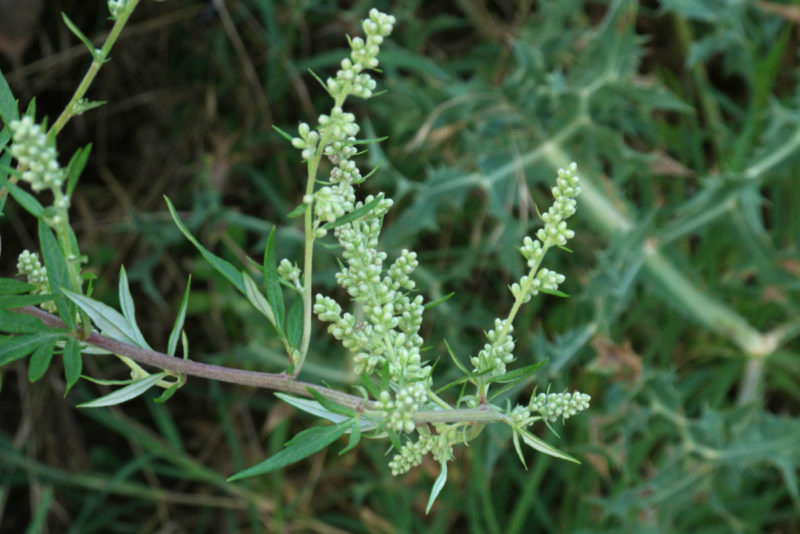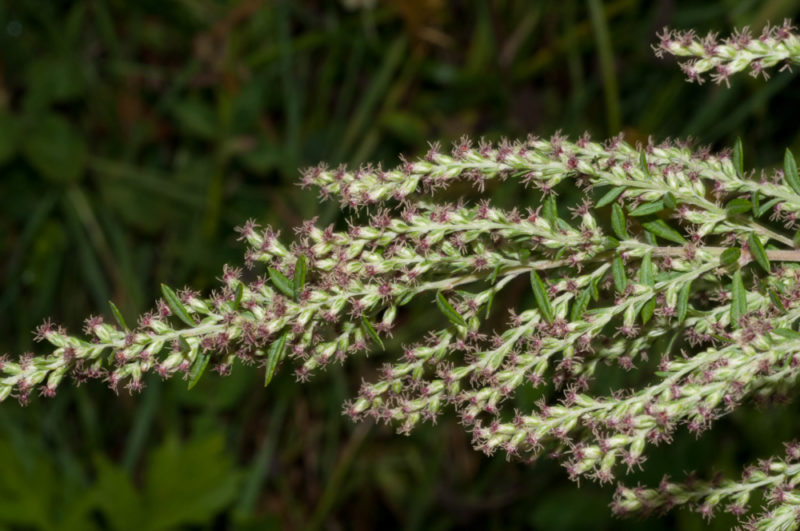Common wormwood is associated with hot summers, country walks and air saturated with the aroma of herbs, in which the incomparable spicy smell of this plant prevails.
Material Content:
Description and healing properties
Common wormwood along with feather grass is a natural litmus of the soil: they do not grow in acidified and waterlogged areas. About four hundred species of wormwood grow in nature, differing in height, appearance, color and shape of leaves, smell, and properties.
Common wormwood, which is called Chernobyl and Chernobyl for the dark color of the stem, is a perennial herbaceous plant of the Astrov family (Latin name Artemisia vulgaris). It occurs along roads, in fields, pastures.
The height of the Chernobyl can reach 2 meters. Its dissected slightly pubescent leaves are small green in the upper part of the stem, and wide light green in the lower part. Wormwood blooms in July - September with small yellow flowers, forming fruit-achenes.
All parts of the plant are rich in useful elements, and since ancient times in many countries drugs were prepared from them for the treatment of diseases.
In our time, wormwood is used:
- in drugs;
- in seasonings for meat dishes;
- in perfumery and cosmetology;
- in the preparation of drinks (it is part of tarragon, vermouth, absinthe);
- for the preparation of green paint;
- to protect houses, gardens and vegetable gardens from harmful insects.
It is better to use medications purchased at a pharmacy, and only after consulting a doctor, on his recommendation.Even the slightest violation of the proportions of a medicinal decoction / tincture or their improper use can lead to a worsening of the condition.
There are many folk recipes for the outdoor use of the medicinal properties of Chernobyl:
- Baths. Apply to relieve fatigue in the legs, joint pain, getting rid of corns. To do this, fresh stems and leaves (within 200 g) are poured with 6 liters of boiling water, insisted to a warm temperature and soar feet, applying wormwood leaves to sore spots.
- Compresses With bruises, bruising, bruises, compresses from the juice of freshly picked crushed leaves, which are applied to problem areas, help.
- Decoctions. A decoction helps strengthen hair and prevent hair loss: pour grass with boiling water in proportions 1:10, insist for at least an hour, strain. This broth month wash your hair every other day. If desired, the procedure can be repeated after 2 to 3 weeks.
Decorative varieties of plants
Decorative varieties of wormwood with openwork dissected leaves of all shades of silver color (from almost white to greenish) serve as a wonderful decoration of the garden, emphasizing the beauty of flowering and ornamental plants. Small nondescript flowers of the plant are usually removed, leaving them only if you want to propagate the variety you like seeds.
Decorative species are divided into short and tall. The first include:
- Steller. Height - 25 - 30 cm, carved silver-white leaves with a pleasant smell. Often used as a groundcover and planted on alpine hills, in borders. Recommended neighbors: clove-grass, phlox, stonecrop, yarrow. A popular variety is Moris Form with silver-metallic foliage.
- Schmidt. Depending on the variety, the height of the spherical bush is 25 - 40 cm, the leaves are silver-green. Planted in borders, slides, in the foreground flower beds. The best varieties: Nana (up to 25 cm) with narrow thin thick leaves, Powus Castle (up to 40 cm) with dissected thick leaves.
- Pursha. Upright stems grow up to 60 cm, they can be cut to the desired height, silvery elongated leaves are slightly pubescent. It serves as a wonderful backdrop for bright colors: roses, phlox, lilies.
- Louis. It grows to 80 cm, but flower growers prefer to pinch the tops to create a compact bush, silver leaves slightly elongated, with serrated endings. Recognized varieties: Valeri Finnig with leaves of greenish-silver color on the outside and white - from the inside, Silver Queen with silver densely pubescent leaves.
Tall:
- Bitter. Its decorative variety attracts silky silver-green leaves with a pleasant aroma. When planting, one must take into account that the phytoncides released can destroy many neighboring flowers, for example, dahlias, carnations. They are usually planted along the fence.
- Jeanlim. In this species, openwork dissected leaves have a unique yellowish-green color.
- Lerhiy. The annual forms pyramidal bushes with fragrant dark green leaves.
- Pontic. The color of the leaves of this species is grayish green above and almost white below.
Outdoor landing
Wormwood is an unpretentious plant, but, choosing a site for planting wormwood, it is necessary to take into account some features:
- the site can be in the sun and in partial shade;
- soil acidity should be neutral;
- the ground should be light and loose, sand should be added to the soil for planting, and drainage should be added to the planting pits;
- groundwater should not come close to the roots of the plant.
You can plant garden bushes in spring and autumn. Like bushes of wild wormwood can also be transferred to the garden, planting in a prepared hole.
After planting, seedlings must be watered.
Care and growing features
Caring for this plant does not require much attention and time. It consists in regular pruning to form a beautiful bush and remove flower stalks (if seed collection is not expected).
Wormwood is watered only when planting; it tolerates even prolonged drought. Once a season, you can feed the crop with ready-made complex fertilizers or "green", prepared from harvested weeds.
The plant is distinguished by strong immunity, therefore, neither disease nor pests are afraid of it. On the contrary, it protects neighboring plantings from unwanted insects.
It must be remembered that some species are aggressive and grow rapidly, inhibiting neighboring plants. In order to avoid capture of the territory by the wormwood when growing wormwood, the roots of the plant are cut or a border tape is dug around the bush.
Plant propagation
Wormwood can be propagated in different ways:
- By dividing the bush. In August - September, an overgrown bush is dug up, divided into several delenki and planted in prepared soil.
- Cuttings. In June, apical shoots are cut at an angle of at least 10 cm long and the resulting cuttings are planted in prepared soil or container.
- The seeds. They can be sown in the soil in the fall or seedlings can be grown in seedlings by sowing seeds in seedlings in the spring, and in the fall by planting seedlings on the site.
Wormwood takes root well and quickly grows. It is only necessary to moisten the soil after planting.
Collection of medicinal raw materials
All parts of wormwood have useful properties, and each has its own harvesting time:
- Leaves are collected before flowering, pinching or cutting them from the stems, but without stalks.
- Stems with leaves and flowers are cut 25-30 cm from the top of the plant. The optimal period for harvesting grass is when all the flower buds or most of them have blossomed.
- Roots and rhizomes are dug in the fall until frost, when the maximum amount of nutrients accumulate in them.
- Seeds can be collected in the early morning or after rain: in wet weather, they have the greatest number of useful elements.
The rest of the wormwood should be prepared in dry weather, immediately sorted out and spread out with a thin layer for drying on a cloth or paper, regularly (once every 1–2 days) turning raw materials over. For this, a warm, shaded, well-ventilated room is suitable.
The readiness of raw materials is determined by the stem: if it breaks easily, the grass can be laid out on paper bags and put away in a cool place.
Dried wormwood can be stored for no more than 2 years.
The use of wormwood in the garden
Wormwood in garden or summer cottage areas provides invaluable benefits.
- It is recommended to plant the plant in near-stem circles of fruit trees - its smell repels many insect pests and mice.
- In autumn, several long wormwood branches are attached to the trunks of apple trees and pears with tape or spar to protect them from mice in winter and from sunburn in spring.
- Wormwood branches are laid out before winter in places where tulip and lily bulbs so beloved with mice and moles are planted
- In the attics and in the basements of the houses, plants are laid out or hanging branches gathered in bunches to get rid of mice.
- Small cloth bags with dry wormwood grass, spread among food and clothing, scare off cockroaches and moths.
- Wormwood broths are also used as an insecticide not only to control pests of fruiting trees - they spray potato bushes from the Colorado potato beetle, fight caterpillars, aphids, late blight, powdery mildew and various fungal diseases of plants, flowers, and bushes.
To prepare the broth, you will need about 700 g of dry grass or about 2 kg of fresh grass. Put grass in a spacious container, fill with water, insist, closing the lid, 2 days. Boil for 20 minutes, strain and bring the amount of water to 10 liters. Spray 3-4 times once a week.
Wormwood in the garden is a fragrant highlight of any landscape design and at the same time a reliable defender of plants, the ability to abandon the use of chemicals to combat pests and diseases of garden plants.















